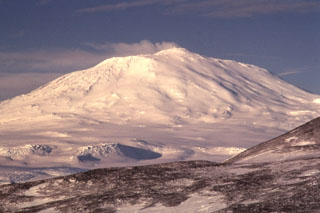Report on Erebus (Antarctica) — November 1994
Bulletin of the Global Volcanism Network, vol. 19, no. 11 (November 1994)
Managing Editor: Richard Wunderman.
Erebus (Antarctica) Gas plume analyses reported
Please cite this report as:
Global Volcanism Program, 1994. Report on Erebus (Antarctica) (Wunderman, R., ed.). Bulletin of the Global Volcanism Network, 19:11. Smithsonian Institution. https://doi.org/10.5479/si.GVP.BGVN199411-390020
Erebus
Antarctica
77.53°S, 167.17°E; summit elev. 3794 m
All times are local (unless otherwise noted)
Since 1974 several expeditions have been organized to evaluate the mass and energy transfer from the magma in the lava lake to the atmosphere. Results have been in the range of 3-230 tons/day (t/d) of SO2. During this time, both the volcanic activity and the methods used to evaluate the gas output have changed. For the 1993-94 campaign both the COSPEC method and the SF6 tracer-gas method were used. A bottle of SF6 gas was driven into the crater and injected into the volcanic plume at a rate of 1.2 l/min. Seventeen sampling bottles installed downwind on the crater rim each sampled the plume for ~1 hour. Analyzing the SF6 concentration in each bottle allowed calculation of the atmospheric transfer coefficient: equal to the ratio of the concentration in the flask to the source SF6 flow rate. By analyzing the concentration of gas or aerosols collected at the same time and place it has been possible to determine the volcanic source output, assuming that the diffusion laws are the same for the artificial and the natural products.
The following results were obtained using the SF6 method (in tons/day): S, 50-80; Cl, 150-240; F, 50-80; Pb, 0.35; Zn, 0.53; As, 0.009; Bi, 0.0011; Cd, 0.01; Mo, 0.003; Cu, 0.19; Au, 0.002. COSPEC results obtained from a distance gave a SO2 flux of 120-150 t/d; an average of 60-75 t/d of sulfur.
CO was analyzed automatically during the cruise between Australia, Antarctica, and New Zealand, at the same time that samples were collected using a metallic cylinder on the crater rim and in the ice cave on the outer slopes of the volcano. The gas samples were analyzed using a trace analytical reduction gas detector connected with a gas chromatograph containing a 2-m molecular sieve column. Reduction gas detection occurs as a result of the passage of certain species through a heated bed of mercuric oxide (HgO); this method allows detection of reducing gases from the low parts per billion (ppb) to low percentages. The average concentration of CO varied between 80 and 120 ppb on the sea between Australia and Antarctica, but in the ice cave the CO concentration reached 152-456 ppb, and in the volcanic plume on the crater rim it reached 1,000-3,000 ppb.
Erebus, the world's southernmost historically active volcano, overlooks the McMurdo research station on Ross Island. The summit has been modified by several generations of caldera formation. The glacier-covered volcano was erupting when first sighted in 1841 and has had an active lava lake in its summit crater since late 1972.
Geological Summary. Mount Erebus, the world's southernmost historically active volcano, overlooks the McMurdo research station on Ross Island. It is the largest of three major volcanoes forming the crudely triangular Ross Island. The summit of the dominantly phonolitic volcano has been modified by one or two generations of caldera formation. A summit plateau at about 3,200 m elevation marks the rim of the youngest caldera, which formed during the late-Pleistocene and within which the modern cone was constructed. An elliptical 500 x 600 m wide, 110-m-deep crater truncates the summit and contains an active lava lake within a 250-m-wide, 100-m-deep inner crater; other lava lakes are sometimes present. The glacier-covered volcano was erupting when first sighted by Captain James Ross in 1841. Continuous lava-lake activity with minor explosions, punctuated by occasional larger Strombolian explosions that eject bombs onto the crater rim, has been documented since 1972, but has probably been occurring for much of the volcano's recent history.
Information Contacts: R. Faivre-Pierret, Institut de Protection et de Surete Nucleaire, Grenoble, France; F. LeGuern, B. Bonsang, E. Demont, M. Le Cloarec, E. Nho, and B. Ardouin, CNRS Centre des Faibles Radioactivites, Gif sur Yvette, France.

